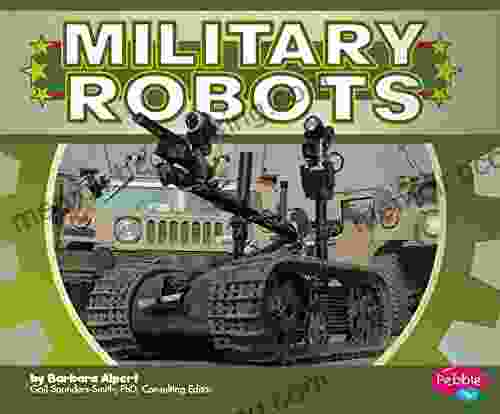Military Robots: The Future of Warfare?

5 out of 5
| Language | : | English |
| File size | : | 34251 KB |
| Print length | : | 24 pages |
Military robots are becoming increasingly sophisticated and are already being used in a variety of roles on the battlefield. From surveillance and reconnaissance to combat and logistics, robots are playing a larger and larger role in modern warfare.
This book examines the history, development, and future of military robots, and explores the ethical and legal implications of their use.
History of Military Robots
The history of military robots can be traced back to the early days of warfare. In the 3rd century BC, the Greek inventor Archytas of Tarentum developed a steam-powered bird that could fly and drop bombs. In the 13th century, the Chinese invented the gunpowder-powered fire lance, which could be used to launch rockets and other projectiles.
In the 19th century, the development of the telegraph and the telephone made it possible to control machines remotely. This led to the development of the first teleoperated military robots, such as the Brennan torpedo and the Kettering Bug.
During World War II, the Germans developed a number of radio-controlled bombs and missiles, including the V-1 flying bomb and the V-2 rocket. The Allies also developed a number of remote-controlled weapons, such as the Diamondback glide bomb and the Hs 293 anti-ship missile.
After World War II, the development of military robots continued at a rapid pace. In the 1950s, the US military developed the first nuclear-powered submarine, the USS Nautilus. In the 1960s, the US military developed the first drones, which were used for reconnaissance and surveillance.
In the 1970s, the US military developed the first cruise missiles, which could be launched from aircraft or ships and could fly long distances to their targets. In the 1980s, the US military developed the first stealth aircraft, which could evade enemy radar detection.
In the 1990s, the US military developed the first unmanned combat aerial vehicles (UCAVs),which could be used to carry out airstrikes without risking the lives of human pilots. In the 2000s, the US military developed the first ground-based combat robots, such as the TALON and the PackBot.
Development of Military Robots
Military robots are becoming increasingly sophisticated and are now able to perform a wide variety of tasks on the battlefield. These tasks include:
* Surveillance and reconnaissance * Combat * Logistics * Mine clearance * Explosive ordnance disposal * Search and rescue * Medical evacuation
Military robots are typically equipped with a variety of sensors, such as cameras, radar, and sonar, which allow them to collect information about their surroundings. They are also typically equipped with weapons, such as machine guns, rockets, and missiles, which allow them to engage enemy targets.
Military robots are becoming smaller, lighter, and more autonomous. This is making them more difficult to detect and defeat. It is also making them more capable of operating in a variety of environments, including urban areas, forests, and deserts.
Future of Military Robots
The future of military robots is uncertain. However, it is likely that they will continue to play a larger and larger role in warfare. As robots become more sophisticated and autonomous, they will be able to perform a wider range of tasks and will be able to operate in more dangerous environments.
This will lead to a number of new challenges for militaries around the world. These challenges include:
* The development of new weapons and technologies to counter robots * The development of new tactics and strategies to use robots in combat * The development of new laws and regulations to govern the use of robots in warfare
These challenges will need to be addressed in Free Download to ensure that robots are used in a responsible and ethical manner.
Ethical and Legal Implications of Military Robots
The use of military robots raises a number of ethical and legal concerns. These concerns include:
* The potential for robots to kill or injure civilians * The potential for robots to be used to commit war crimes * The potential for robots to be used to violate international law
These concerns need to be addressed in Free Download to ensure that robots are used in a responsible and ethical manner.
Military robots are becoming increasingly sophisticated and are already being used in a variety of roles on the battlefield. The future of military robots is uncertain, but it is likely that they will continue to play a larger and larger role in warfare. This will lead to a number of new challenges for militaries around the world, including the development of new weapons and technologies to counter robots, the development of new tactics and strategies to use robots in combat, and the development of new laws and regulations to govern the use of robots in warfare. These challenges will need to be addressed in Free Download to ensure that robots are used in a responsible and ethical manner.
5 out of 5
| Language | : | English |
| File size | : | 34251 KB |
| Print length | : | 24 pages |
Do you want to contribute by writing guest posts on this blog?
Please contact us and send us a resume of previous articles that you have written.
 Book
Book Novel
Novel Page
Page Chapter
Chapter Text
Text Story
Story Genre
Genre Reader
Reader Library
Library Paperback
Paperback E-book
E-book Magazine
Magazine Newspaper
Newspaper Paragraph
Paragraph Sentence
Sentence Bookmark
Bookmark Shelf
Shelf Glossary
Glossary Bibliography
Bibliography Foreword
Foreword Preface
Preface Synopsis
Synopsis Annotation
Annotation Footnote
Footnote Manuscript
Manuscript Scroll
Scroll Codex
Codex Tome
Tome Bestseller
Bestseller Classics
Classics Library card
Library card Narrative
Narrative Biography
Biography Autobiography
Autobiography Memoir
Memoir Reference
Reference Encyclopedia
Encyclopedia Ashlee Lewis
Ashlee Lewis Anita Yasuda
Anita Yasuda Anita Cortez
Anita Cortez Anna Crowley Redding
Anna Crowley Redding Anne Corley Baum
Anne Corley Baum Anita Ganeri
Anita Ganeri Balazs Csigi
Balazs Csigi Anna Kang
Anna Kang Anthony Aries
Anthony Aries Anne Griffin Perry
Anne Griffin Perry Barbara Hussmann Long
Barbara Hussmann Long Barbara Lee
Barbara Lee Ariel Landy
Ariel Landy Amy Alexander
Amy Alexander Anne Mendelson
Anne Mendelson Anders Morley
Anders Morley Anthony Bourdain
Anthony Bourdain Anna Corba
Anna Corba Ariana Dimitrakis
Ariana Dimitrakis Andrea Gillies
Andrea Gillies
Light bulbAdvertise smarter! Our strategic ad space ensures maximum exposure. Reserve your spot today!
 Chuck MitchellFollow ·12k
Chuck MitchellFollow ·12k Heath PowellFollow ·19.9k
Heath PowellFollow ·19.9k Jarrett BlairFollow ·14.6k
Jarrett BlairFollow ·14.6k Oscar BellFollow ·6.7k
Oscar BellFollow ·6.7k Samuel Taylor ColeridgeFollow ·5.6k
Samuel Taylor ColeridgeFollow ·5.6k Shane BlairFollow ·5.1k
Shane BlairFollow ·5.1k Levi PowellFollow ·11.6k
Levi PowellFollow ·11.6k Milton BellFollow ·16.7k
Milton BellFollow ·16.7k

 Brayden Reed
Brayden ReedTeach Your Child They Have No Self Worth And They Will...
By Dr. Jane Doe ...

 Shawn Reed
Shawn ReedUnveiling Centuries of Tradition: History of Childbirth...
Journey into the heart of the...

 Brady Mitchell
Brady MitchellProven Guidelines For Healthy Multiple Pregnancy
Congratulations on your...

 Dylan Mitchell
Dylan MitchellHarness the Power of Sleep for Optimal Health and...
In the fast-paced,...

 Herman Melville
Herman MelvilleAlexander Hamilton: The Revolutionary Who Shaped...
Alexander Hamilton was a...
5 out of 5
| Language | : | English |
| File size | : | 34251 KB |
| Print length | : | 24 pages |














